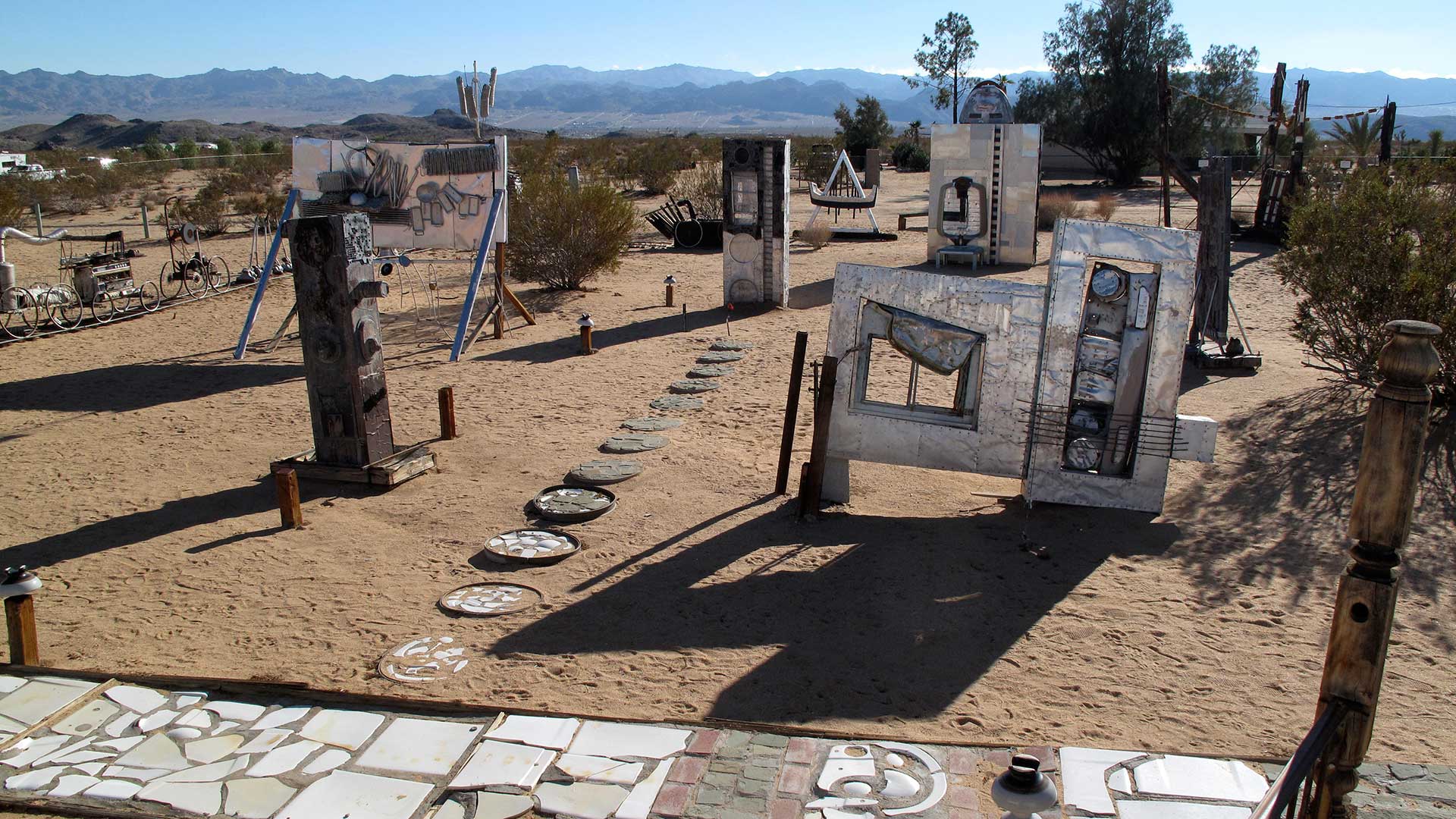

Noah Purifoy made art out of discarded objects: street refuse, industrial machinery, home appliances, bicycles. And cars. So many cars.
Purifoy constructed elaborate vitrines, sculptures, installations, landscapes, humanoids, vehicles and buildings out of these discarded objects—whether recognizable as such or not—painted or left pure and bare.
Born to sharecropper parents in Alabama in 1917, Purifoy learned firsthand the value—physical, functional, symbolic—that items held, even once their utility had seemingly been exhausted. Formally educated at the Chouinard Art Institute (now CalArts) starting in 1950, Purifoy applied this knowledge to the history of art, referencing the “readymades” of toilet tricksters like Marcel Duchamp as well as the works of Surrealists and Dadaists.

But for Purifoy, a discarded object could also be imbued with deeper meaning, particularly if it were subject to a transformation. This was poignantly rendered in his first collection of sculptures, made from debris rescued from the streets of Watts following the unrest that charred large portions of that Los Angeles neighborhood in 1965. This work was key in the landmark group show 66 Signs of Neon, in which Purifoy was featured, and which traveled to multiple venues in the closing years of that turbulent decade.
“Discarded objects had so many points of reference to Purifoy,” says Franklin Sirmans, head of the contemporary art department at the Los Angeles County Museum of Art (LACMA), who curated Noah Purifoy: Junk Dada, a gorgeous retrospective on view at LACMA through the end of September. Sirmans was particularly interested in Purifoy’s connection to those items that act as tribute or testimonial, what he described as “an object that has gone through some sort of event, that then imbues it with a certain power, and can be used therefore as a sort of memorial type of object.”
In the late Eighties, after spending years working to bring the arts to underserved communities, Purifoy moved to the desert, to Joshua Tree, just outside of Palm Springs, to work on his art full time. There he developed a new, broader style, though one still rooted in found objects. Granted, Purifoy discovered that in the desert, objects had room to stretch out.

“The desert is where some of those car parts really come into play,” Sirmans says. “It was a different relationship to junk than it was in the city. In the city, he walked out of his studio and collected stuff right there in front of him on the sidewalk. When he got to the desert, it was about the car, and that being a sort of carcass out there at times. It was the kind of place where, unfortunately [for car lovers], cars were seen in the same light as his other objects, as pieces to be used for making something new, especially when discarded and not being used for their original function. He was giving them second life.”
Purifoy wasn’t the only contemporary artist of that era who used the automobile, or elements of it, as a key part of his material repertoire. “I think Purifoy was in direct conversation with a lot of the artists of his generation, like John Chamberlain, like Robert Rauschenberg,” Sirmans says, noting two of Purifoy’s car-fixated contemporaries. “They were really interested in how these materials related to popular culture, which relates back to the idea of the car.”
Many of Purifoy’s later works have now been preserved in the desert at the Noah Purifoy Foundation’s Joshua Tree Outdoor Museum. Though perhaps preserved is not the precise word. Given the extreme conditions of the desert ecosystem, these pieces are constantly shifting: fading, fringing, rusting, twisting.

The large-scale work may be Purifoy’s most grand, and perhaps his best known. But one piece in the LACMA show stood out for its formal beauty, and for its subject knowledge in the use of an automotive component. This was a piece called Untitled (Radiator Pink and Yellow) made in 1998 from a car radiator. A radiator cools by providing a very large surface area over which air—and through which coolant—can pass, in the most compact possible space. In this piece, the radiator was entirely unfurled, as well as painted and combined with other objects in a tight frame, to create a mesmerizing and detailed yet confined maze—the divided space reminiscent of Mondrian and Reinhardt, the metal fins delicate finials.
It was not only a beautiful and playful undoing of the engineered structure of the object, unpacking the packed-in, but a testimony to the value of exploding the known. This is Purifoy’s magic, and it must be seen to be believed.
Noah Purifoy: Junk Dada is on view at LACMA through September 27. Purifoy’s work is on permanent display at the Noah Purifoy Foundation’s Joshua Tree Outdoor Museum.